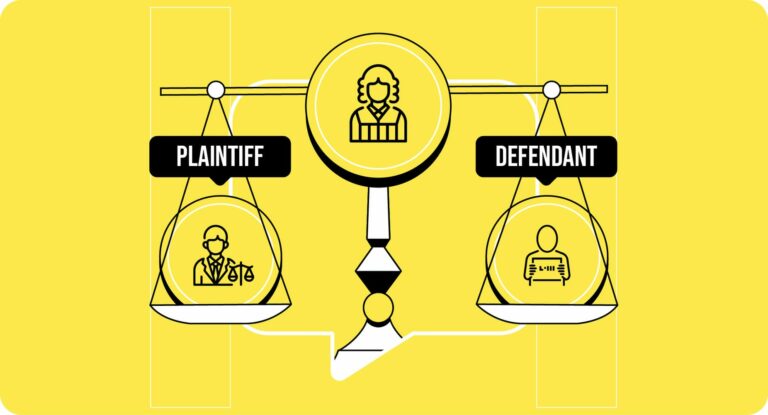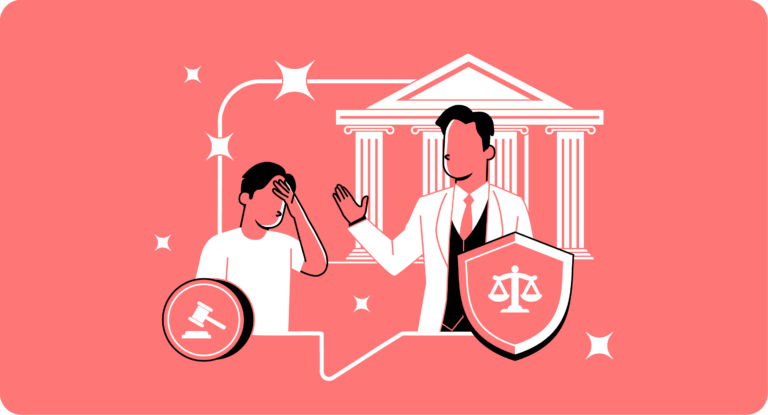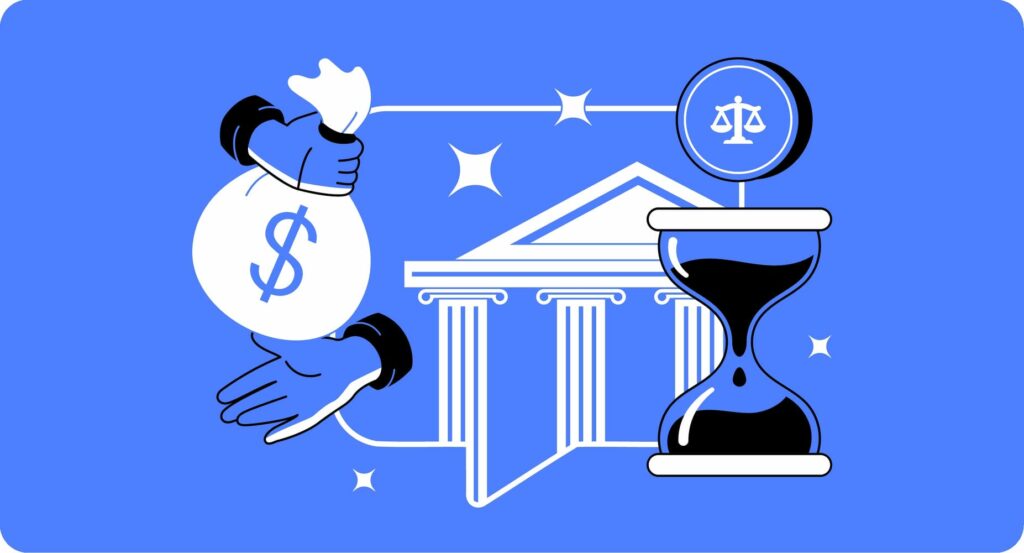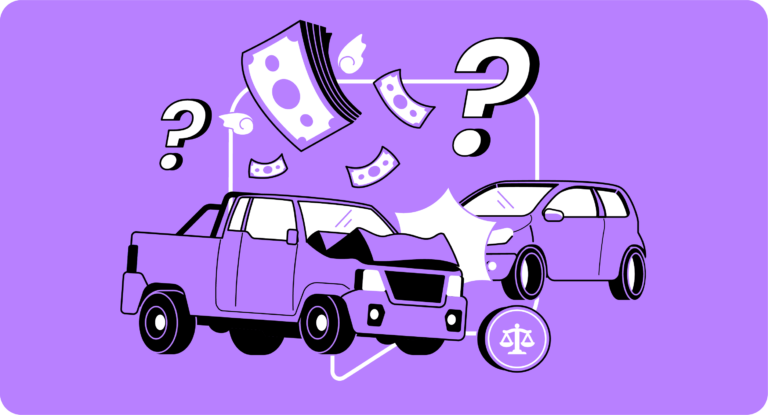The plaintiff is the person or entity initiating the lawsuit and seeking compensation or relief, while the defendant is the person or entity being sued and accused of wrongdoing.
In a civil case, like a car accident or a slip-and-fall incident, you step into the plaintiff’s shoes if you’re injured due to someone else’s negligence. This means you’re initiating the lawsuit, seeking compensation for medical bills, lost wages, and pain and suffering.
Conversely, the person or entity you believe caused your injuries becomes the defendant. Their role is to defend themselves against your accusations. They might argue they weren’t negligent, that your injuries were pre-existing, or that you share some blame. Here is a complete guide our personal injury team put together for you.
Who is the plaintiff in a personal injury case?
The plaintiff is the injured party who initiates a lawsuit against the party they believe is responsible for their injuries. In California, this could be an individual, a family member on behalf of a loved one, or even a business that has suffered losses due to someone else’s negligence or intentional actions.
Example
Let’s say a driver runs a red light and collides with another vehicle, causing the other driver to suffer a broken leg and extensive damage to their car. In this scenario, the driver who was hit would be the plaintiff. They would file a personal injury lawsuit against the driver who ran the red light, seeking compensation for their medical bills, lost wages, pain and suffering, and the cost of repairing their vehicle.
How does a plaintiff prove their case in California?
In California personal injury cases, the plaintiff carries the burden of proof. They must provide enough evidence to convince the court that it’s more likely than not (a “preponderance of the evidence”) that the defendant’s actions or negligence caused their injuries, which might include:
This evidence can include medical records, witness testimonies, expert opinions, and documentation of damages.
What types of damages can a plaintiff seek in California?
California law allows plaintiffs to seek various damages to compensate them for their losses. These include:
- Economic damages: Covering tangible expenses such as medical bills, lost wages, property damage, and rehabilitation costs.
- Non-economic damages: Addressing intangible losses like pain and suffering, emotional distress, loss of enjoyment of life, and loss of consortium.
- Punitive damages: Awarded in cases of gross negligence or intentional misconduct to punish the defendant and deter similar behavior.
Note
California adheres to a ”pure comparative negligence” rule, meaning that even if the plaintiff is partially at fault for the accident, they can still recover damages. However, their compensation will be reduced based on their percentage of fault. For instance, if the plaintiff is found 30% at fault, their award will be reduced by 30%.An experienced personal injury attorney can guide plaintiffs through ensuring their rights are protected, gathering and presenting compelling evidence, negotiating with insurance companies, and advocating for their best interests in court.
Who can be a plaintiff in a California personal injury case?
The term “plaintiff” isn’t limited to a single individual. Depending on the circumstances, various parties can step into this role to seek justice and compensation:
- Individuals: These are the most common individuals who have suffered personal injuries due to another’s negligence or intentional acts.
- Family Members: In cases of wrongful death due to the injuries sustained, their family members can file a wrongful death lawsuit as plaintiffs. They can also sue for loss of consortium, which refers to the loss of companionship, support, or affection caused by the injury.
- Businesses can also be plaintiffs in personal injury cases. For example, a company might sue for damages if its employees were injured by a defective product used in the workplace or if a company vehicle was involved in an accident caused by another driver’s negligence.
- Legal Guardians: In situations where the injured party is a minor or lacks the legal capacity to represent themselves, a legal guardian can act as the plaintiff.
Tip
Knowing your legal options is the first step towards recovery, whether you’re an injured individual, a family member seeking justice for a loved one or a business impacted by another’s negligence.

Who is the defendant in a personal injury case?
The defendant is the individual, company, or entity accused of causing harm or injury to the plaintiff in a personal injury lawsuit. In California, the defendant could be a driver in a car accident, a property owner responsible for a slip and fall, a product manufacturer in a product liability case, or any other party alleged to have acted negligently or intentionally.
Example
Let’s say a cyclist is hit by a car while riding through an intersection. The cyclist suffers a broken leg and other injuries. They sued the car driver for negligence, claiming that the driver ran a red light and caused the accident. In this scenario:
- Plaintiff: The cyclist
- Defendant: The driver of the car
As the defendants mustered to respond to the cyclist’s lawsuit and present evidence to support their defense, their attorney might argue that the cyclist was at fault for the accident, perhaps by not obeying traffic signals or riding recklessly.
What are the defendant’s rights and responsibilities in a California lawsuit?
Defendants in California personal injury cases have several necessary rights and responsibilities, including:
- Right to legal representation: The defendant can hire an attorney to represent their interests and defend them against the plaintiff’s claims.
- Right to respond to the complaint: The defendant must file a formal response to the plaintiff’s complaint, either admitting or denying the allegations.
- Right to present evidence: The defendant can gather and present evidence to support their defense, including witness testimony, expert opinions, and documents.
- Right to a fair trial: The defendant is entitled to a fair trial, where both sides can present their case, and the judge or jury decides the outcome based on the evidence.
Defenses a defendant can use in personal injury cases
Defendants in personal injury cases can employ various legal defenses to challenge the plaintiff’s claims, such as:
- Denial of liability: The defendant may argue that they were not at fault for the accident or that their actions did not cause the plaintiff’s injuries.
- Comparative negligence: If the plaintiff is partially responsible for their injuries, the defendant may argue that their liability should be reduced accordingly.
- Assumption of risk: In some cases, the defendant may argue that the plaintiff voluntarily assumed the risk of injury by engaging in a particular activity or being in a specific situation.
- Pre-existing conditions: The defendant may argue that the plaintiff’s injury existed before the accident and use medical records or doctor testimonies to support this claim.
What happens if the defendant is found liable in California?
If the court finds the defendant liable for the plaintiff’s injuries, they may be ordered to pay damages. These damages can include:
- Economic damages (medical bills, lost wages)
- Non-economic damages (pain and suffering, emotional distress)
- Sometimes, punitive damages (to punish the defendant for egregious conduct)nt of damages awarded will depend on the severity of the plaintiff’s injuries and the case’s specific circumstances.
The litigation process
A civil lawsuit in California typically follows these steps:
- Filing the Complaint: The plaintiff initiates the lawsuit by filing a complaint with the court. This document outlines the plaintiff’s legal claims, the factual basis for those claims, and the relief sought (e.g., monetary damages, injunction).
- Service of Process: The defendant is formally notified of the lawsuit through service of process, which involves delivering a copy of the complaint and a summons.
- Answer: The defendant responds to the complaint by filing an answer, admitting or denying the allegations, and asserting any defenses.
- Discovery: Both parties engage in discovery, gathering evidence relevant to the case. This may involve depositions (oral testimony under oath), interrogatories (written questions), and requests for production of documents.
- Pre-Trial Motions: The parties may file motions to resolve the case or limit the issues for trial. Typical motions include motions to dismiss and motions for summary judgment.
- Trial: If the case is not resolved through pre-trial motions or settlement, it proceeds to trial. In a bench trial, a judge decides the case. In a jury trial, a jury decides the factual issues, and the judge applies the law.
- Verdict and Judgment: The judge or jury issues a verdict, and the judge enters a judgment based on the verdict.
- Appeal: The losing party may appeal the judgment to a higher court.
Note
Many civil cases in California are resolved through settlement negotiations. The parties, often with the assistance of their attorneys, discuss the strengths and weaknesses of their respective cases and attempt to reach a mutually agreeable resolution. Factors that influence the decision to settle or proceed to trial include:
- The strength of each party’s case
- The potential costs of litigation
- The desire to avoid the uncertainty of a trial
- The willingness of the parties to compromise
Alternative dispute resolution in California
In California, navigating the complexities of a civil lawsuit doesn’t always have to culminate in a courtroom showdown. Parties can explore alternative dispute resolution (ADR) methods, offering a less adversarial and often more efficient route to resolution.
Mediation
This process involves a neutral third party, the mediator, facilitating communication between the plaintiff and defendant. The mediator doesn’t make decisions but helps the parties reach a mutually agreeable settlement. California courts often encourage or even mandate mediation in some instances, recognizing its potential to save time and resources.
Arbitration
This involves a more formal process where a neutral third party, the arbitrator, hears evidence and arguments from both sides and renders a decision. Arbitration can be binding, meaning the decision is final and enforceable.
Or non-binding, allowing parties to proceed to trial if they disagree with the outcome. California law supports arbitration agreements and generally upholds arbitration awards unless there’s evidence of fraud, bias, or other misconduct.
Why choose ADR?
ADR methods offer several advantages over traditional litigation:
- Reduced Cost: ADR is typically less expensive than going to trial, as it avoids lengthy court proceedings and associated legal fees.
- Faster Resolution: ADR often results in quicker resolutions than the drawn-out litigation process.
- Increased Control: Parties have more control over the process and outcome in ADR as they actively participate in crafting a resolution.
- Confidentiality: ADR proceedings generally protect sensitive information from public disclosure.
- Preserving Relationships: ADR can help maintain relationships between parties by fostering communication and collaboration rather than confrontation.
Whether it’s a car accident, a slip-and-fall incident, or any other civil dispute, exploring ADR options can be a valuable path toward achieving a fair and satisfactory resolution.
If you want to know more about your legal options, we want to help
Whether you’re facing a personal injury, contract dispute, or family law issue, seeking counsel from a qualified attorney is crucial in protecting your interests. We can clarify the legal process, offer personalized advice tailored to your situation, and advocate tirelessly for the best possible outcome in your case.
With an experienced attorney, you can confidently navigate the legal landscape with the knowledge and resources necessary to achieve a favorable resolution. Schedule a consultation today and take the first step towards securing the expert guidance and unwavering support you deserve.










